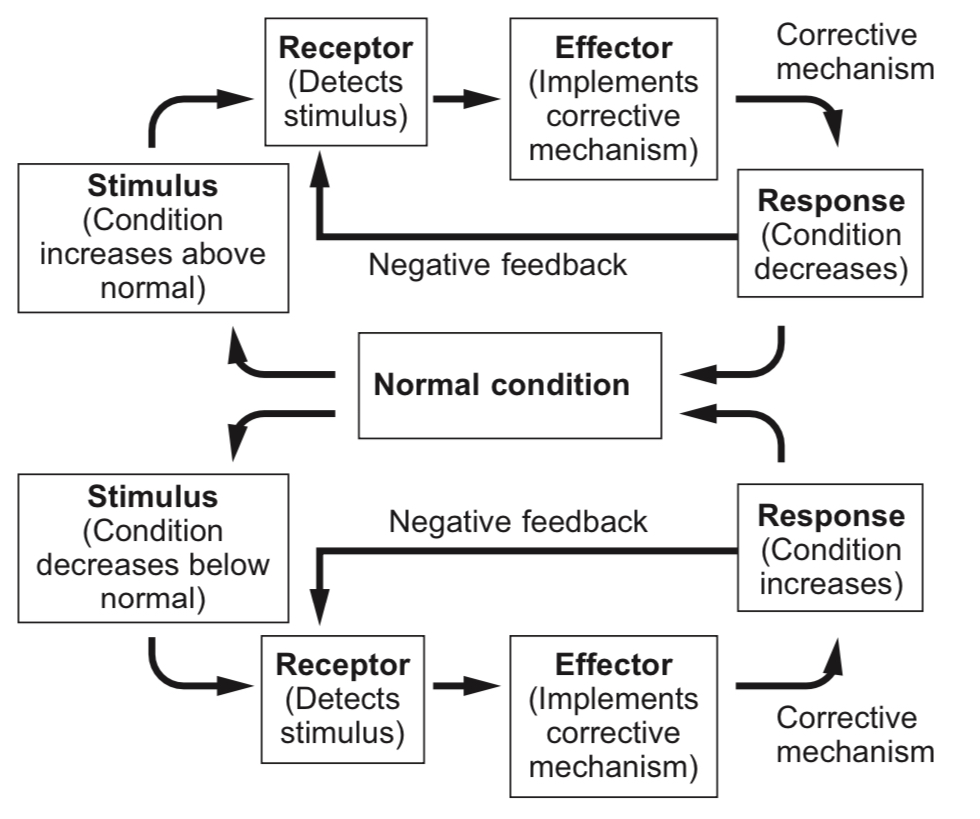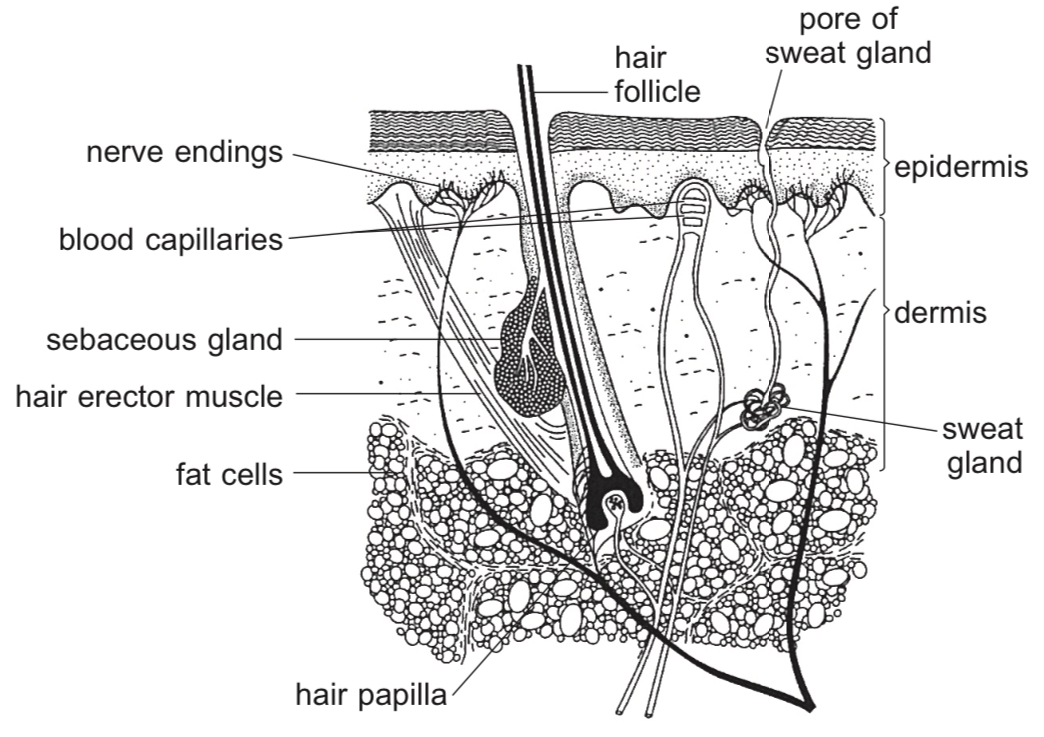Chapter 11 - Homeostasis
Homeostasis
Homeostasis is the maintenance of a constant internal environment. It allows an organism to survive in a changing environment.
It involves: (a) Thermoregulation – the maintenance of a constant body temperature
(b) Osmoregulation – the maintenance of a constant water potential and pH
Thermoregulation is the maintenance of body temperature within a range that will allow cells to function effectively.
Many body processes, including metabolism, involve enzymes, which have an optimal temperature range.
Large body temperature changes could affect the rate of cellular respiration or alter membrane properties.
Osmoregulation is important because changes in the water potential could affect the direction of osmosis in body cells and the electrolyte balance across cell membranes.
Homeostasis involves a process called negative feedback. Negative feedback is a corrective mechanism in which the body’s response is to restore the normal conditions of the internal environment.
Terms involved in negative feedback control mechanism: (a) Stimulus – A change in internal environment (b) Receptor – Sense organs that detect the stimulus (c) Effector – Effect corrective responses (d) Response – Condition returns to normal, gives negative feedback to receptor

Structure of Skin

The skin comprises two layers: the epidermis and the dermis.
The epidermis is the outermost layer which forms a waterproof and protective covering.
The dermis is the layer containing hair follicles, sweat glands, sebaceous glands, blood vessels and thermoreceptors.
The arterioles leading to the capillaries in the dermis are controlled by nerves. They respond to stimulation by undergoing vasoconstriction and vasodilation.
Vasoconstriction is the contraction of smooth muscles in the arteriole walls. It decreases the diameter of the blood vessels, reducing blood flow. The skin looks pale when vasoconstriction takes place.
Vasodilation is the relaxation of smooth muscles in the arteriole walls. It increases the diameter of the blood vessels, increasing blood flow. The skin becomes flushed when vasodilation takes place.
Hairs grow within the hair follicles. Attached to the hair follicles are sebaceous glands which produce sebum, and hair erector muscles, which raise hair.
Sweat glands are coiled tubes that secrete sweat through a sweat duct. Secreted sweat contains water, sodium chloride and small amounts of metabolic waste products.
Sweat glands are used for body temperature regulation.
Nerve endings of sensory neurones enable pressure, pain or temperature changes to be detected.
Beneath the skin is a layer which consists of connective tissue and adipose tissue. Adipose cells store fat. This layer serves as insulation and padding.
Thermoregulation
Heat is produced by metabolic activities within the body. Most heat is produced by the liver, the brain, the heart and the contraction of skeletal muscles.
Heat can be removed from the body by conduction, convection and radiation if the environmental temperature is lower than the body temperature. Otherwise, heat would be gained.
Heat can be removed through evaporation of sweat.
The skin participates in thermoregulation through vasoconstriction, vasodilation and sweating.
The hypothalamus in the brain regulates body temperature by receiving information about temperature changes from thermoreceptors located in the skin and within the hypothalamus itself, and activating mechanisms that promote heat gain or loss.
When the external temperature rises above normal levels, thermoreceptors within the skin send signals to the hypothalamus in the brain. Any corresponding rise in blood temperature is also detected by thermoreceptors located within the hypothalamus itself. The hypothalamus is stimulated to send out nerve impulses to:
(a) Arterioles in the skin, stimulating vasodilation. Increased blood flow in superficial capillaries causes more heat loss through conduction, convection and radiation.
(b) Sweat glands, stimulating sweat production. Heat is lost through evaporation of sweat from the skin.
(c) Hair erector muscles, which relax so that hair follicles lie flat. This ensures that no air is trapped by the hairs as air is a good insulator. This is more evident in animals.
(d) Lungs, stimulating rapid breathing or panting. Heat is lost through exhaled air. This is also more evident in animals.
Body temperature returns to normal.
When the external temperature falls below normal levels, thermoreceptors in the skin send signals to the hypothalamus. A decrease in blood temperature is also detected by thermoreceptors in the hypothalamus. The hypothalamus is stimulated to send out nerve impulses to: (a) Arterioles in the skin, stimulating vasoconstriction. Decreased blood flow in superficial capillaries causes less heat loss through conduction, convection and radiation.
(b) Sweat glands, stopping sweat production
(c) Hair erector muscles, which constrict so that hair follicles are raised. This traps a layer of air between the hairs which acts as an insulating layer.
(d) Muscles, causing involuntary and increased contraction of muscles, known as shivering. This increases cellular respiration in muscle cells, producing heat.
Body temperature returns to normal.
In humans, the always-present layer of adipose tissue beneath the skin acts as insulation.
 Knowt
Knowt
